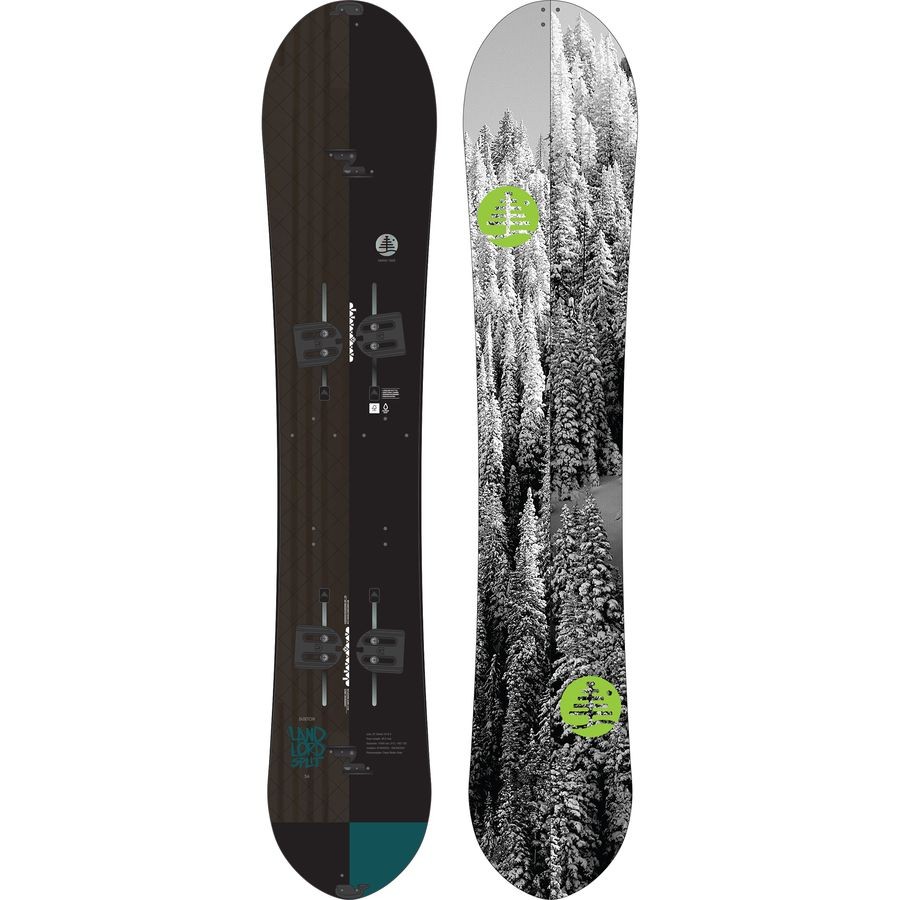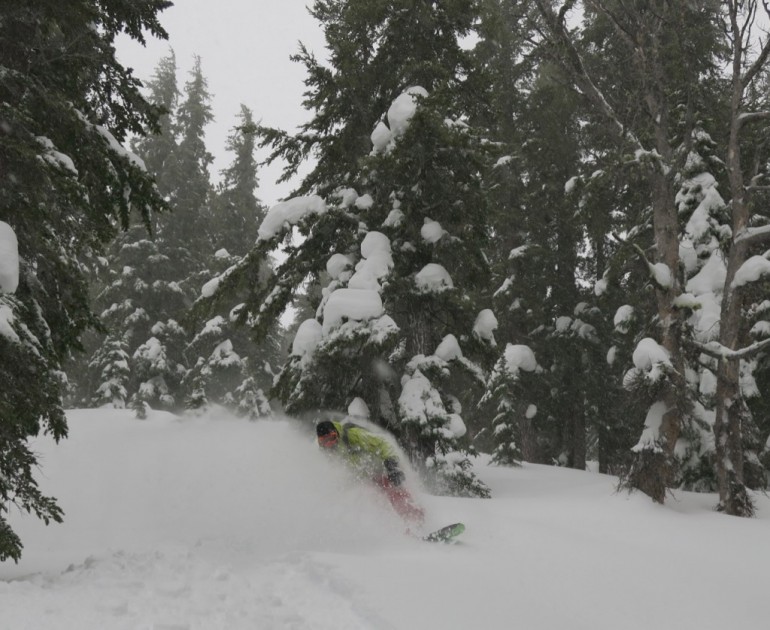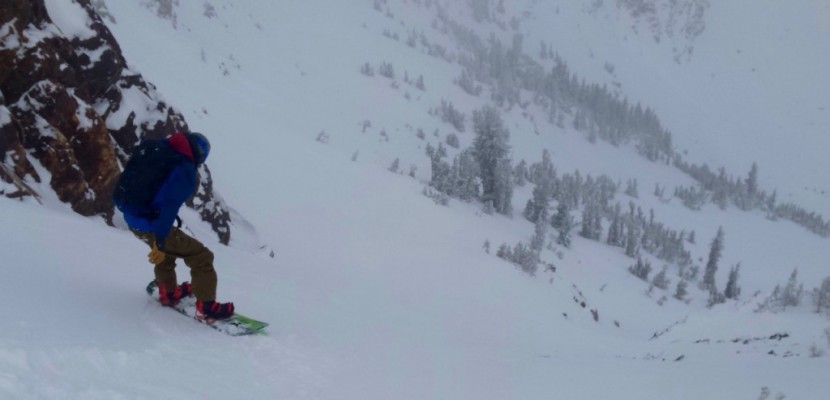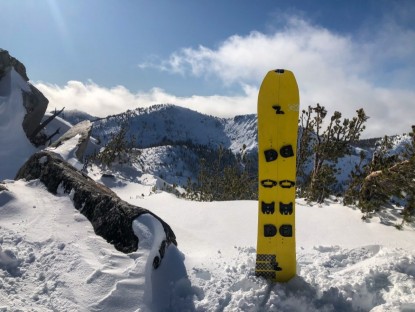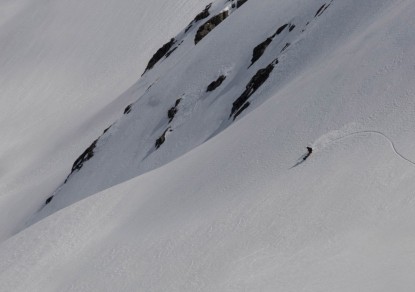"Rides like a solid!" was the enthusiastic impression of more than one reviewer after their first lap on the Burton Family Tree Landlord. Winning our Editors' Choice Award, we certainly felt that it rides as such. What makes this splitboard an award winner? While this board is one of the heavier boards in our review, which hurt it in the climbing category, it scored very well in other areas and ended up being one of our most popular boards across several categories. While several other boards in our review are focused on the big mountain part of the freeride category, this board is definitely more freestyle focused. This is what reviewers noticed after their first runs on this award winner and what tilted the scales in favor overall. Other splitboards in our review were close in overall score; if your focus is more on big mountain riding, the Jones Solution might be a better fit for you.
Riders will find boards in our review that ride well in all conditions, as well as in specific terrain; this board excells in the freestyle aspects of riding down a mountain. Other boards in our review charge downhill very well, but don't encourage the same amount of freestyle shenanigans often due to their stiffer flex. On spring splitboard mountaineering missions where firm snow is likely to be encountered, those stiffer boards would likely be a better call. For typical midwinter backcountry snowboarding excursions, we found this split to offer up the most fun. While all the boards in our test rode well, there is something telling about the feedback we reviewed from testers. This company has tons of experience crafting snowboards that appeal to a variety of riders; because of this, they were able to produce a splitboard that riders instantly appreciated. We introduce to you our new Editors' Choice Award-winning splitboard!Burton Landlord Review
Our Verdict
Our Analysis and Test Results
Hands-On Review
The Family Tree Landlord wins Editors' Choice as it performed well in both resort pow days and resort groomer days and was our first choice of the review quiver for either type of day. This board pulled off a multitude of positives, which included railing switch carves, into an exaggerated trench making euro carve, into a BS 180 off the edge of a run — all within the abilities of this model. Bombing through the trees during storm day resort laps was a joy; multiple reviewers performed little butter moves that weren't highly impressive but were easier to execute on this board versus any other split in our review, although the Jones Explorer was close behind.
Powder
This board is very fun to ride in powder. We awarded it 9 out of 10 points in the powder metric, which was the highest percentage in our ranking system. The nose works in conjunction with the early riser rocker and tapers to quickly lift the board above the pow. The sidecut feels quick and agile and encourages darting around trees and lining up jumps. It features 17mm of taper, helping the tail sink more than the nose; 17mm is within the range found in our review fleet. As a point of comparison, the Burton Fish Split, a powder specific design, features 30mm of taper. This helps the Fish in powder, but potentially hurts it in other areas. The moderate amount of taper makes this board a more all-around design instead of a dedicated power board like the afore mentioned Fish Split. Compromise is inherent in building an all-around performance splitboard and Burton seems to have skillfully threaded the needle with this model.
Firm Snow
Climbing
This board was the heaviest in our review (weighing 7lbs, 8.6oz) and received a relatively low 6 out of 10 in this category. All the boards fell within a similar and narrow weight range. Looking at the weight per surface area chart is likely more useful information than the actual weight of the board as it tries to account for different lengths and shapes (though ultimately, total weight does matter when climbing). Splitboards spend the vast majority of their life ascending, so being on the wrong side of this is not a great position to occupy.
This model features slightly set back camber under foot which helps maintain solid skin grip on the ascents. The nose and setback camber do a great job of staying above powder when breaking trail on the skin track, making this board one of the best in our review at breaking trails while skinning. The camber under the bindings helps maintain a long point of ski contact with the snow which results in solid skin grip when ascending a firm skin track. A splitboard with zero camber and/or pronounced rocker between the bindings can result in less skin grip while ascending firm skin tracks. Heavier reviewers did notice that the while sidehilling on firm snow, the skis would flex significantly. This can be an issue, especially for heavier riders who will flex the ski more. Stiffer boards like the Never Summer Prospector or Jones Solution might be better fits for heavier riders.
A tighter turn radius will make it tougher to engage the entire inside edge of the downhill ski when sidehilling. When sidehilling, most splitboarders notice their downhill ski is more likely to slip (than their uphill ski) since the straight inner edge is engaging the slope on the upper ski, while the curved outer edge is engaging the slope on the downhill ski. This splitboard features a fairly tight sidecut radius (7.5m), which exacerbates the challenge of engaging the downhill ski on steep sidehills. For general splitboard touring or storm day lapping at your local powder hill, this is not a concern; when tackling longer, steeper tours on firmer snow, this less-than-stellar grip might be a significant issue.
An experienced snowboarder can roughly predict performance of a board based solely on the geometry of its design. In general, this splitboard's performance does follow what we would anticipate based upon its board design. Yet its impressively high level of performance exceeds what we can attribute solely to its specifications. The weight is actually a little higher than what we would prefer to see for a splitboard and we hesitate to assign positive attributes to this weight, though it is possible that the small amount of additional heft does contribute to some of its strong riding attributes.
Binding Adjustability
This splitboard has a channel puck system. The pucks that come with the board are flat, not canted. Although we were impressed with all of the channel systems in our review, the possibility of losing the screws if the pucks are removed does make us a little nervous (though we do give Burton credit for including rubber spacers in the channels to try to prevent this from happening). Unfortunately, the rubber spacers fell out pretty quickly and were ineffective at holding in the screws. This is mostly a moot point since the board ships with pucks; the screws can't slide out with pucks mounted and there is little reason to ever remove the pucks.
Playfulness
We awarded this board 9 out of 10 points (the highest score in the review) for really standing out in this category. In feature filled backcountry runs, we found ourselves jumping and tweaking more on this board than on any of the other rides. While a directional deck favors riding forward over riding switch, we enjoyed turning this board around and pushing the switch limits (and our abilities). When pounding out resort days, this model's freestyle focus was evident and encouraged the most butters and 180s. Of all the boards we rode, mixing in freestyle moves was easiest on this board. If this aspect of snowboarding appeals to you, this board would be a great fit.
Karma Score
After being an early splitboard innovator, Burton neglected the category for years. Thankfully that seems to have changed recently and they now offer several splitboard options. This model features Forest Stewardship Council (FSC) certified wood, with the FSC certification meaning that the wood is produced from responsibly managed forests.
Best Applications
Picture an epic early season backcountry powder day in which we found ourselves enjoying the performance of this board on a mostly pow filled backcountry line. Now picture us enjoying it so much so that we opened it up full speed and forcefully smacked a hidden rock. After an impressive rag doll, the reviewer emerged unscathed, and the board remarkably had only a small core shot. A completely cracked deck or a total edge blowout would have been understandable given the impact, though it is important to note that if the rock had been an inch closer to the edge, the results very well could have been different. It is impossible to objectively evaluate all the splitboards on how they would handle a severe impact like this, but this model passed this particular test.
The board doesn't feature any particularly innovative specifications. The taper, sidecut, and overall shape are very much within the the standards of conventional snowboard design. Many of the other boards in our review overlap in terms of design, like the traditional camber underfoot that is shifted back towards the tail. The increased nose rocker combined with this camber profile is found in some form on several of the splitboards in our review. What is impressive is not the design, but in the execution of that design. The 7.5m sidecut radius looks tight on paper and contributes to making the board zip around trees on a powder run, though advanced riders might be concerned that this tight turn radius will make the board unstable at speed. Compared to the other contenders in our review, this splitboard felt stable on fast open alpine terrain; the softer flex hurt stability a little while speeding through chopped up or cruddy snow. Still, it handled these conditions better than the flex alone might suggest.
Value
At $850, this split is one of the three most expensive splitboards in our review, along with the Jones Solution and Never Summer Prospector. If you are looking for a fun board that excels in powder and encourages trickery, you should be able to justify the price.
Conclusion
The Landlord received the most initial praise of any board in our review. If you enjoy catching air and mixing a few tricks into your descents, you should consider this board, though is not necessarily the best choice for steep descents in firm conditions. While it could certainly handle those types of missions, the Jones Solution would be a better fit. Additionally, heavier riders should consider sizing up or perhaps choosing a stiffer board. Something like the Solution, Never Summer Prospector, or Voile Revelator would be best if you prefer a stiffer splitboard. That said, if you find yourself buckled into this split atop a few thousand feet of powder-covered terrain with cliffs and bumps dotting the path down, it's likely you will be smiling at the bottom.


